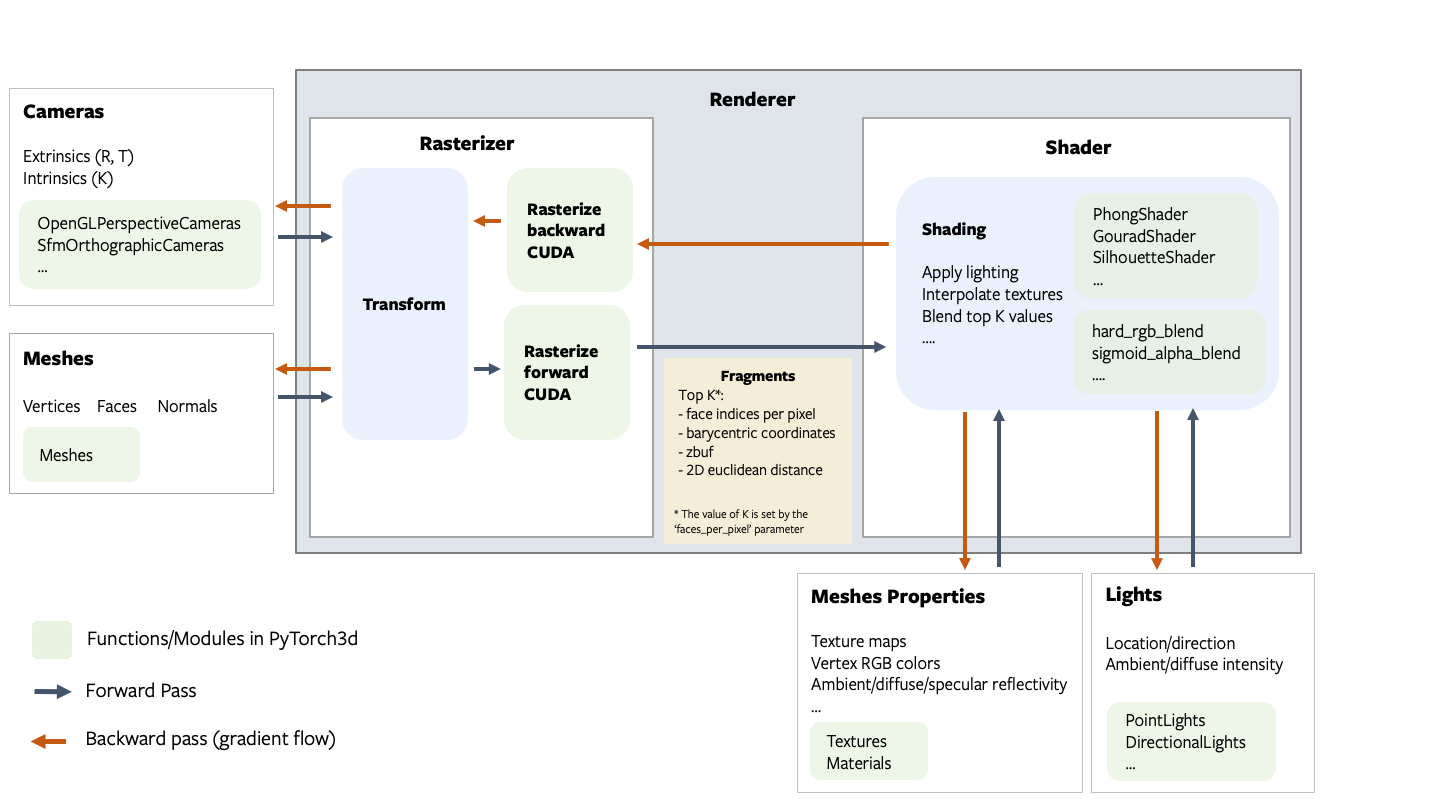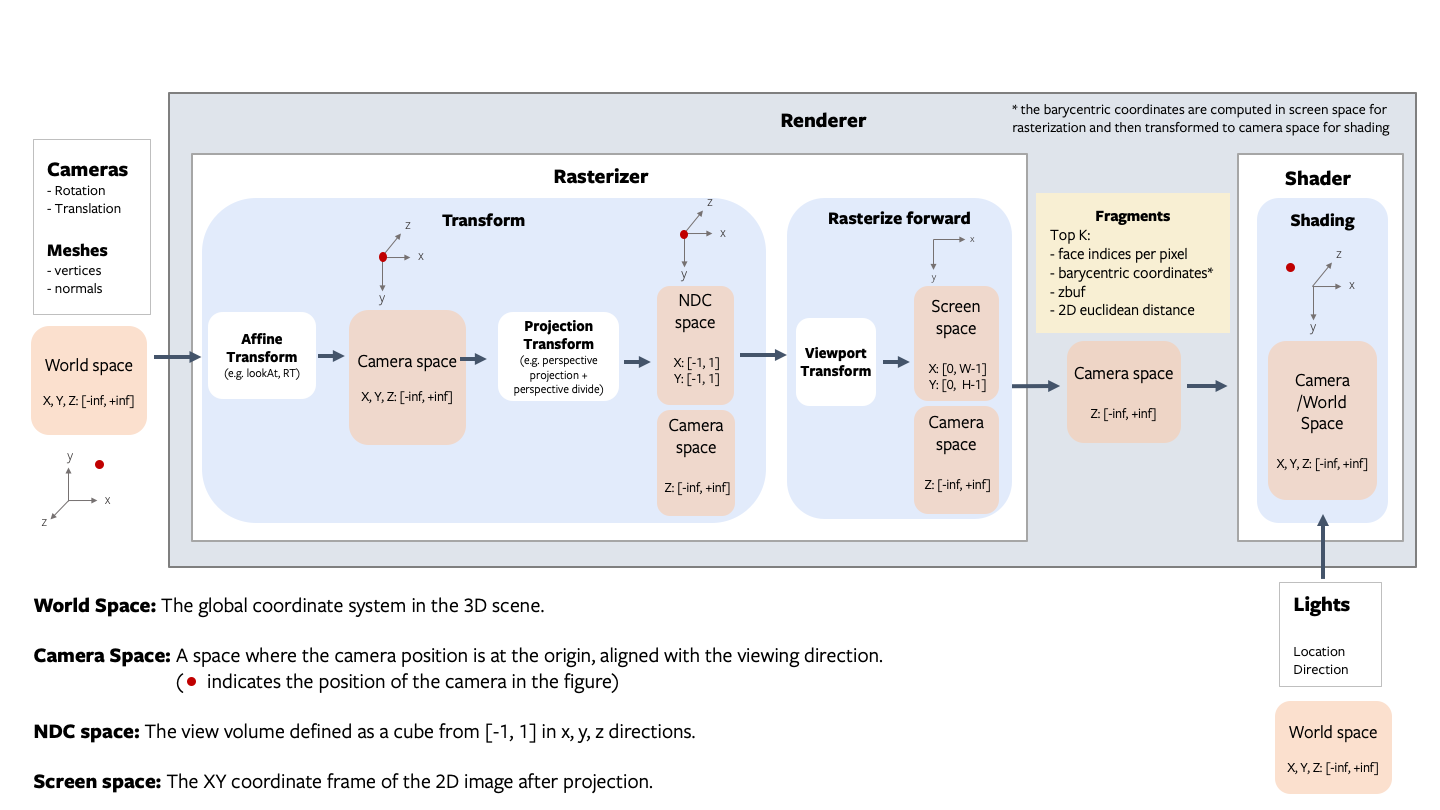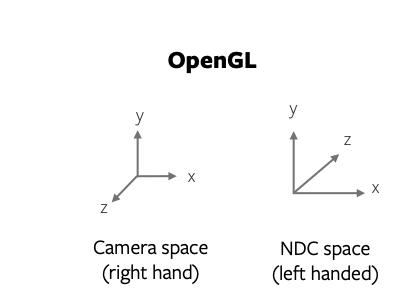Summary: Renamed shaders to be prefixed with Hard/Soft depending on if they use a probabalistic blending (Soft) or use the closest face (Hard). There is some code duplication but I thought it would be cleaner to have separate shaders for each task rather than: - inheritance (which we discussed previously that we want to avoid) - boolean (hard/soft) or a string (hard/soft) - new blending functions other than the ones provided would need if statements in the current shaders which might get messy. Also added a `flat_shading` function and a `FlatShader` - I could make this into a tutorial as it was really easy to add a new shader and it might be a nice showcase. NOTE: There are a few more places where the naming will need to change (e.g the tutorials) but I wanted to reach a consensus on this before changing it everywhere. Reviewed By: jcjohnson Differential Revision: D19761036 fbshipit-source-id: f972f6530c7f66dc5550b0284c191abc4a7f6fc4
5.2 KiB
hide_title, sidebar_label
| hide_title | sidebar_label |
|---|---|
| true | Getting Started |
Renderer Getting Started
Architecture Overview
The renderer is designed to be modular, extensible and support batching and gradients for all inputs. The following figure describes all the components of the rendering pipeline.

Fragments
The rasterizer returns 4 output tensors in a named tuple.
pix_to_face: LongTensor of shape(N, image_size, image_size, faces_per_pixel)specifying the indices of the faces (in the packed faces) which overlap each pixel in the image.zbuf: FloatTensor of shape(N, image_size, image_size, faces_per_pixel)giving the z-coordinates of the nearest faces at each pixel in world coordinates, sorted in ascending z-order.bary_coords: FloatTensor of shape(N, image_size, image_size, faces_per_pixel, 3)giving the barycentric coordinates in NDC units of the nearest faces at each pixel, sorted in ascending z-order.pix_dists: FloatTensor of shape(N, image_size, image_size, faces_per_pixel)giving the signed Euclidean distance (in NDC units) in the x/y plane of each point closest to the pixel.
See the renderer API reference for more details about each component in the pipeline.
NOTE:
The differentiable renderer API is experimental and subject to change!.
Coordinate transformation conventions
Rendering requires transformations between several different coordinate frames: world space, view/camera space, NDC space and screen space. At each step it is important to know where the camera is located, how the x,y,z axes are aligned and the possible range of values. The following figure outlines the conventions used PyTorch3d.

NOTE: PyTorch3d vs OpenGL
While we tried to emulate several aspects of OpenGL, the NDC coordinate system in PyTorch3d is right-handed compared with a left-handed NDC coordinate system in OpenGL (the projection matrix switches the handedness).
In OpenGL, the camera at the origin is looking along -z axis in camera space, but it is looking along the +z axis in NDC space.

A simple renderer
A renderer in PyTorch3d is composed of a rasterizer and a shader. Create a renderer in a few simple steps:
# Imports
from pytorch3d.renderer import (
OpenGLPerspectiveCameras, look_at_view_transform,
RasterizationSettings, BlendParams,
MeshRenderer, MeshRasterizer, PhongShader
)
# Initialize an OpenGL perspective camera.
R, T = look_at_view_transform(2.7, 10, 20)
cameras = OpenGLPerspectiveCameras(device=device, R=R, T=T)
# Define the settings for rasterization and shading. Here we set the output image to be of size
# 512x512. As we are rendering images for visualization purposes only we will set faces_per_pixel=1
# and blur_radius=0.0. Refer to rasterize_meshes.py for explanations of these parameters.
raster_settings = RasterizationSettings(
image_size=512,
blur_radius=0.0,
faces_per_pixel=1,
bin_size=0
)
# Create a phong renderer by composing a rasterizer and a shader. Here we can use a predefined
# PhongShader, passing in the device on which to initialize the default parameters
renderer = MeshRenderer(
rasterizer=MeshRasterizer(cameras=cameras, raster_settings=raster_settings),
shader=PhongShader(device=device, cameras=cameras)
)
A custom shader
Shaders are the most flexible part of the PyTorch3D rendering API. We have created some examples of shaders in shaders.py but this is a non exhaustive set.
A shader can incorporate several steps:
- texturing (e.g interpolation of vertex RGB colors or interpolation of vertex UV coordinates followed by sampling from a texture map (interpolation uses barycentric coordinates output from rasterization))
- lighting/shading (e.g. ambient, diffuse, specular lighting, Phong, Gourad, Flat)
- blending (e.g. hard blending using only the closest face for each pixel, or soft blending using a weighted sum of the top K faces per pixel)
We have examples of several combinations of these functions based on the texturing/shading/blending support we have currently. These are summarised in this table below. Many other combinations are possible and we plan to expand the options available for texturing, shading and blending.
| Example Shaders | Vertex Textures | Texture Map | Flat Shading | Gourad Shading | Phong Shading | Hard blending | Soft Blending |
|---|---|---|---|---|---|---|---|
| HardPhongShader | ✔️ | ✔️ | ✔️ | ||||
| SoftPhongShader | ✔️ | ✔️ | ✔️ | ||||
| HardGouradShader | ✔️ | ✔️ | ✔️ | ||||
| SoftGouradShader | ✔️ | ✔️ | ✔️ | ||||
| TexturedSoftPhongShader | ✔️ | ✔️ | ✔️ | ||||
| HardFlatShader | ✔️ | ✔️ | ✔️ | ||||
| SoftSilhouetteShader | ✔️ |